|
An importent leader
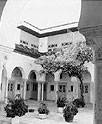 At the dawn of the 18th century, in spite of the acute crisis which opposed Hussein Ben Ali Turki to his son-in-law Ali Pasha, Tunis seemed to reappear of its ashes. Mosque Al-jadid (the news) was born in the street of the dyers to which was added, a few years later, the médersa of same name (Al-jadida). At the dawn of the 18th century, in spite of the acute crisis which opposed Hussein Ben Ali Turki to his son-in-law Ali Pasha, Tunis seemed to reappear of its ashes. Mosque Al-jadid (the news) was born in the street of the dyers to which was added, a few years later, the médersa of same name (Al-jadida).
Others médersas more and more beautiful than the previous centuries were built, the majority by Ali Bey, the winner of Hussein Ben Ali, probably in the hope of making forget his dept toward his uncle whom he decapitated at the time of the ultimate battle that he delivered against him close to Kairouan. The head of the defeated was then brought back to Tunis and buried in the mausoleum of Sidi kasim Have-Sababti adjacent with mosque Al-jadid. Year-Nakhla Al-Bachiya, Have-Slimaniya, Al-Achouriya, Bir lahjar and others, all these médersas testify by way of an undeniable revival, as well on the economic plan as social and intellectual.
Tunis became again at the 18th century the commercial big city dreaded by Europeans, where food and luxury items of all sources were abounded and where considerable fortunes were made up thanks to the international business and the race.
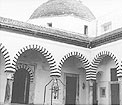 The minister Youssef Saheb And-Tabaa was one of these fortunate to whom are in the must around 1800, the marvellous and large mosque of the Halfaouine place as well as the unit “Kullulié” of Othoman tradition grouping souk Al-jadid, the palace, the médersa, and the fountain. Same period, (beginning of the 19th century) date also repair of the external ramparts by the large bey builder Hamouda Pasha who made call for this delicate work with Dutch engineer Homberg. It ordered, in the same way, the construction of a large number of barracks right in the middle of the medina the such barracks of the souk-attarine (old seat of the National library), that of the street jamâa Ezzitouna (appendix of the aforesaid library) and that of the Sadiki hospital… The minister Youssef Saheb And-Tabaa was one of these fortunate to whom are in the must around 1800, the marvellous and large mosque of the Halfaouine place as well as the unit “Kullulié” of Othoman tradition grouping souk Al-jadid, the palace, the médersa, and the fountain. Same period, (beginning of the 19th century) date also repair of the external ramparts by the large bey builder Hamouda Pasha who made call for this delicate work with Dutch engineer Homberg. It ordered, in the same way, the construction of a large number of barracks right in the middle of the medina the such barracks of the souk-attarine (old seat of the National library), that of the street jamâa Ezzitouna (appendix of the aforesaid library) and that of the Sadiki hospital…
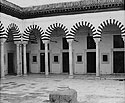 At the same time, it build new palates or extended the old ones like Dar El Bey with the Kasbah, Dar Hussein instead of castle and the very new palate of the Rose in Manouba (currently museum of the Army). At the same time, it build new palates or extended the old ones like Dar El Bey with the Kasbah, Dar Hussein instead of castle and the very new palate of the Rose in Manouba (currently museum of the Army).
From this period, dates also marvellous Zaouia de Sidi Brahim, in the street of the same name, close to Dar Lasram (seat of the Association of Safeguard of the Medina) built by the rich family to Lasram, dignitaries of the court beylical and land great landowners. Dar Ben Abdullah which accommodates the Museum of Art’s nowadays and Popular Traditions, not far from the street of the dyers, constitutes a jewel very representative of this beautiful architecture husseinite which testifies to an often disproportionate will for power compared to real resources of the holders of richness’s.
The best example is undoubtedly the palate than built Ahmed Bey in the middle of the 19th century in full shift on the road of Zaghouan which would have, in the spirit of its founder, 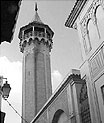 not only to eclipse the palate of Bardo (founded in 1400 and several times increased and embellished by the various sovereigns of Tunis, currently divided between the Museum of Bardo and the National Assembly), but still not compete with the size and glare of the palace of Versailles which seemed to have fascinated the Tunisian sovereign. not only to eclipse the palate of Bardo (founded in 1400 and several times increased and embellished by the various sovereigns of Tunis, currently divided between the Museum of Bardo and the National Assembly), but still not compete with the size and glare of the palace of Versailles which seemed to have fascinated the Tunisian sovereign.
With his death in 1855, its successor Mohamed Bey choosed to settle in another palate of the suburbs of Marsa, dedicating Mohammedia with the abandonment and the ruin; ruin which surprises you today by its gigantic aspect and which marks the memory of a dream - as quickly disappeared as carried out conceived by a kindly bey, Ahmed Bey (1837-1855). From 1830, date of the occupation of Algeria by France and especially since 1850, the race in the Mediterranean had become increasingly difficult and the interventions of the European powers in the increasingly offensive interior matters of Regency.
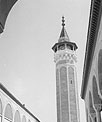 A new district inhabited by Europeans of all sources: Maltese, Italians, Greeks, French etc were established in front of “Bab Bhar” -the door of the sea-, before even the establishment of French protectorate in 1881, where a splendid residence of the French Consul was drawn up (1861) to replace the old buildings of Fondouk of the French located at the “franko” hood , where since the Middle Ages, the consuls of the European nations had taken the practice to build their residences doubled of a room (fondouk) to accommodate men, animals and goods. A new district inhabited by Europeans of all sources: Maltese, Italians, Greeks, French etc were established in front of “Bab Bhar” -the door of the sea-, before even the establishment of French protectorate in 1881, where a splendid residence of the French Consul was drawn up (1861) to replace the old buildings of Fondouk of the French located at the “franko” hood , where since the Middle Ages, the consuls of the European nations had taken the practice to build their residences doubled of a room (fondouk) to accommodate men, animals and goods.
A new world, an abandoned city
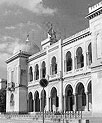 The creation of a suitable city for colonization close to the old one was not, obviously, without carrying serious damages to this one. It was the same for the competition of the European manufactured goods and the passage of the foreign trade between the hands of the foreign colony. The middle-class town and the political aristocracy and private soldier at the same time of and the income financial resources of the state of the trade, were not any more in measurement, with rare exceptions, to maintain their beautiful residences and even less to build such prestigious news of them. The “ulemas”, scientists and teachers of the large mosque, could not also them , resist too long to the influence of teaching and scientific of the modern teaching which was given is within the framework of the French colleges or with the Sadiki College founded since 1875 by the reforming minister, the general Khéreddine. The creation of a suitable city for colonization close to the old one was not, obviously, without carrying serious damages to this one. It was the same for the competition of the European manufactured goods and the passage of the foreign trade between the hands of the foreign colony. The middle-class town and the political aristocracy and private soldier at the same time of and the income financial resources of the state of the trade, were not any more in measurement, with rare exceptions, to maintain their beautiful residences and even less to build such prestigious news of them. The “ulemas”, scientists and teachers of the large mosque, could not also them , resist too long to the influence of teaching and scientific of the modern teaching which was given is within the framework of the French colleges or with the Sadiki College founded since 1875 by the reforming minister, the general Khéreddine.
At the end of the 20th century, the University of Ezzitouna and with it, all the Tunisian company fell in full crisis. The battle from now on committed between partisans of the “tradition” and pioneers of “modernity” will be long and with heavy of consequences.
The elites will be formed preferably in the French schools or free-Arabic.
The Medina, with the image of the company which lives it, translates in the stone this crisis of the authenticity.
Given up or almost by the most favored populations attracted by the European model of the habitat in apartments or in villas, it changed during one half-century into privileged refuge of the least affluent and rural arrived downtown in search of work.
|